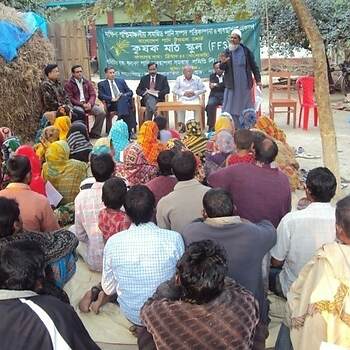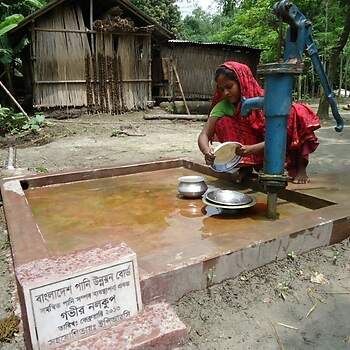This timeframe started with the independence of Bangladesh in 1971 after a fierce liberation war. Once Bangladesh was independent from Pakistan, it started to receive development aid in its own right, including from the Dutch government. The latter always included aid for water projects and programmes.
Water Management
The 1970s saw a clear donor-driven shift away from large-scale mega projects to small-scale projects. Simultaneously, the Green Revolution pushed for rapid rural mobilization of farmers through a multi-tiered cooperative model. Cooperatives were then institutionalized through the Department of Cooperatives and firmly tied to rural development in Bangladesh. The ‘Comilla model’ in turn influenced the structure of water management organizations as cooperatives registered under the Department of Cooperatives.
The Comilla Model was a rural development program launched in 1959 by the Pakistan Academy for Rural Development, renamed in 1971 as the Bangladesh Academy for Rural Development. The objective of the model was that agricultural and rural development would be based on the principle of grassroots cooperative participation by the local people.
The Netherlands became involved in several water management projects, mainly in the coastal area, in particular the Early Implementation Project (EIP), the Delta Development Project (DDP) and the Land Reclamation Project (LRP). See a description of the EIP below.
Early Implementation Project (EIP): In 1975 a cooperation program started between the GoB and the GoN. EIP’s objective was to protect agriculture land from floods through construction of embankments and sluices. The initial contribution of GoN was to support relatively small labour-intensive, quick-yielding water sector sub-projects through the Bangladesh Water Development Board (BWDB). These sub-projects had mainly a rehabilitation and relief character. They needed comparatively limited technical preparation and could therefore, in theory, start early: hence the name Early Implementation Project. The EIP technical assistance was truly embedded in the BWDB organisation and procedures. A team of international and national experts worked closely with BWDB to identify and prepare the sub-projects, as well as supervising their implementation. The project cycle was usually kept short i.e. within three years. The annual investment plans of EIP were based on assessments by GoN experts.
Gradually, the project changed its scope and objective and went through distinct phases from a technical construction to integrated participatory planning and implementation, also informed by the findings of socio-economic surveys. During the process, EIP drew the attention of other donors. In 1981 the Government of Sweden became a partner in EIP, and continued its support till 1992. Over the years, EIP has implemented 88 sub-projects in various regions of Bangladesh, covering an area of 463,250 ha. The implemented sub-projects consisted of the development of haors (dish shaped depressions within a perimeter consisting of river levees) and polders, including the excavation of canals, construction of sluices, closures on small rivers, and embankments. The project was very successful, also due to good relations with the BWDB at all levels. The EIP format was copied by other agencies (e.g. LGED) in different places of Bangladesh.
For the water management projects supported by the Netherlands the most relevant institutions are:
- Bangladesh Water Development Board (BWDB) implementing the FCD/FCDI and other development projects
- Water Resources Planning Organization (WARPO) for macro planning
- River Research Institute (RRI) responsible for physical and mathematical water modeling
- Institute of Water Modeling (IWM) for mathematical water modeling
- Center for Environmental and Geographic Information Services (CEGIS) for integrated environmental analysis using GIS, remote sensing, database and IT.
These institutions were established in different periods of time from Bangladesh’s independence onwards. They all come under the current Ministry of Water Resources (MoWR), which was named the Ministry of Irrigation, Water Development and Flood Control (MoIWDFC) until 1993. MoWR is responsible for policies and implementation of development projects relating to flood control, and drainage and irrigation (FCD / FCDI); riverbank erosion control; delta development and land reclamation. In addition to the MoWR and its institutions, also the Local Government Engineering Department (LGED) and the Union Parishads -the lowest level for local government- are involved in water management projects, in particular within the small scale projects.
The new Bangladesh Government started its initial intervention in the water supply and sanitation sector with the objective of building an effective service delivery mechanism. In the first years after independence, in 1971, the Government laid emphasis on the rehabilitation of damaged water supply and sanitation services and installation of new facilities in rural and urban areas through the Department of Public Health Engineering (DPHE). Services were provided mostly free of charge. At that time the role of the users in decision-making, cost sharing and operations and maintenance was negligible.
After independence, the Department of Public Health Engineering (DPHE) remained responsible for the water and sanitation infrastructure development and services of the whole country, including in urban areas, except for Dhaka and Chittagong (Chattogram) cities, for which in 1983 separate Water Supply and Sewerage Authorities (WASA) were established. In rural areas such facilities are installed by the DPHE in close cooperation with the Union Parishads, the lowest level of local government. Over time, DPHE started collaboration with the private sector, NGOs and CBOs, both in urban and rural areas. Also the Local Government Engineering Department (LGED), municipalities, and academic and research institutions, e.g. the Bangladesh University of Engineering and Technology (BUET), became involved in WSS service delivery and related research.
In 1978 the Netherlands started providing technical and financial assistance to the implementation of drinking water supply projects in Bangladesh through DPHE. Four projects were implemented with Dutch support since 1978, mainly in District towns. The first two were the Khulna and Rajshahi water supply projects implemented between 1978-1980. Their activities included the preparation of a Master Plan, expansion of the water supply system, water conservation and leak detection, institutional strengthening of the municipal corporation.
The third project was the 12 Sub-Divisional Towns Project (12 DTP), which started in 1981, to upgrade and expand the water supply systems in 12 towns. The fourth project was the 18 Town Project, which started in 1989. More information on these two projects can be found under the next bullets.
In rural areas the main focus within the WASH sector was the installation of hand-tubewells in villages for drinking water. Pre-1970, tubewells had been mainly used for irrigation, but in the 1970s and 1980s there was a successful campaign to promote tubewells for drinking water as a means to create access to safe drinking water replacing the use of -often unsafe- surface water. As a result there were some 2,5 million tubewells by 1990, with about 90% of the rural population were using water from this source.

